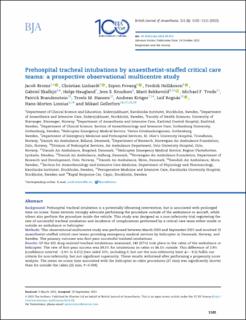| dc.contributor.author | Broms, Jacob | |
| dc.contributor.author | Linhardt, Christian | |
| dc.contributor.author | Fevang, Espen | |
| dc.contributor.author | Helliksson, Fredrik | |
| dc.contributor.author | Skallsjö, Gabriel | |
| dc.contributor.author | Haugland, Helge | |
| dc.contributor.author | Knudsen, Jens S. | |
| dc.contributor.author | Bekkevold, Marit | |
| dc.contributor.author | Tvede, Michael F. | |
| dc.contributor.author | Brandenstein, Patrick | |
| dc.contributor.author | Hansen, Troels M. | |
| dc.contributor.author | Krüger, Andreas Jørstad | |
| dc.contributor.author | Rognås, Leif Kåre | |
| dc.contributor.author | Lossius, Hans Morten | |
| dc.contributor.author | Gellerfors, Mikael | |
| dc.date.accessioned | 2024-02-21T12:00:08Z | |
| dc.date.available | 2024-02-21T12:00:08Z | |
| dc.date.created | 2023-11-09T12:56:43Z | |
| dc.date.issued | 2023 | |
| dc.identifier.citation | Broms, J., Linhardt, C., Fevang, E., Helliksson, F., Skallsjö, G., Haugland, H., ... & Gellerfors, M. (2023). Prehospital tracheal intubations by anaesthetist-staffed critical care teams: a prospective observational multicentre study. British Journal of Anaesthesia, 131(6), 1102-1111. | en_US |
| dc.identifier.issn | 0007-0912 | |
| dc.identifier.uri | https://hdl.handle.net/11250/3118996 | |
| dc.description.abstract | Background
Prehospital tracheal intubation is a potentially lifesaving intervention, but is associated with prolonged time on-scene. Some services strongly advocate performing the procedure outside of the ambulance or aircraft, while others also perform the procedure inside the vehicle. This study was designed as a non-inferiority trial registering the rate of successful tracheal intubation and incidence of complications performed by a critical care team either inside or outside an ambulance or helicopter.
Methods
This observational multicentre study was performed between March 2020 and September 2021 and involved 12 anaesthetist-staffed critical care teams providing emergency medical services by helicopter in Denmark, Norway, and Sweden. The primary outcome was first-pass successful tracheal intubations.
Results
Of the 422 drug-assisted tracheal intubations examined, 240 (57%) took place in the cabin of the ambulance or helicopter. The rate of first-pass success was 89.2% for intubations in-cabin vs 86.3% outside. This difference of 2.9% (confidence interval −2.4% to 8.2%) (two sided 10%, including 0, but not the non-inferiority limit Δ=−4.5) fulfils our criteria for non-inferiority, but not significant superiority. These results withstand after performing a propensity score analysis. The mean on-scene time associated with the helicopter in-cabin procedures (27 min) was significantly shorter than for outside the cabin (32 min, P=0.004).
Conclusions
Both in-cabin and outside the cabin, prehospital tracheal intubation by anaesthetists was performed with a high success rate. The mean on-scene time was shorter in the in-cabin helicopter cohort. | en_US |
| dc.language.iso | eng | en_US |
| dc.publisher | Elsevier | en_US |
| dc.rights | Navngivelse 4.0 Internasjonal | * |
| dc.rights.uri | http://creativecommons.org/licenses/by/4.0/deed.no | * |
| dc.title | Prehospital tracheal intubations by anaesthetist-staffed critical care teams: a prospective observational multicentre study | en_US |
| dc.type | Peer reviewed | en_US |
| dc.type | Journal article | en_US |
| dc.description.version | publishedVersion | en_US |
| dc.rights.holder | The authors | en_US |
| dc.subject.nsi | VDP::Medisinske Fag: 700 | en_US |
| dc.source.pagenumber | 1102-1111 | en_US |
| dc.source.volume | 131 | en_US |
| dc.source.journal | British Journal of Anaesthesia | en_US |
| dc.source.issue | 6 | en_US |
| dc.identifier.doi | 10.1016/j.bja.2023.09.013 | |
| dc.identifier.cristin | 2194556 | |
| cristin.ispublished | true | |
| cristin.fulltext | original | |
| cristin.qualitycode | 2 | |

